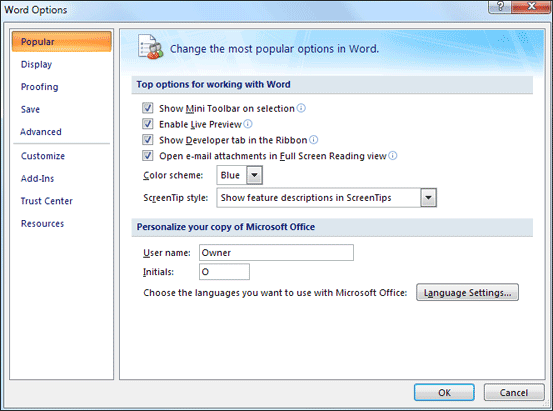

Word will automatically add that language tag to your Normal style, which is the default style for text in a new blank document. Go to Tools>Language, select a Language, and click Default. New documents will behave, although you will need to fix old documents one-by-one. Then anytime you use that style in the future, it will automatically have the language tags. You need to modify the style that the text is formatted in, to include the language formatting. Fixing All Documents, or Changing the Default Language Spelling depends on the language setting, so first make sure you have a Tools>Language menu entry. Note: the Word 2004 Help topic "Troubleshoot spelling and grammar checking" also addresses some questions not covered here. Tools>Spelling & Grammar Dialog Stops Showing Suggestions.Spanish Custom Dictionary-FIXED with Office 2004 SP2 (11.2).
 There Is No "Language" on My Tools Menu. The Spelling & Grammar Preferences Are Grayed Out. Change Language in a Single Click in Word 2008 (external link, scroll down for English). Spell-Check Doesn’t Catch Misspelled Words. Updated for Word 2008 (DRAFT in Progress) You can also import and create custom dictionaries here if required for particular documents.Spell-Checking, Language, and Dictionary Issues in MacWord Adding or removing terms as required and clicking OK to confirm. Selecting your custom dictionary (usually named CUSTOM.DIC).
There Is No "Language" on My Tools Menu. The Spelling & Grammar Preferences Are Grayed Out. Change Language in a Single Click in Word 2008 (external link, scroll down for English). Spell-Check Doesn’t Catch Misspelled Words. Updated for Word 2008 (DRAFT in Progress) You can also import and create custom dictionaries here if required for particular documents.Spell-Checking, Language, and Dictionary Issues in MacWord Adding or removing terms as required and clicking OK to confirm. Selecting your custom dictionary (usually named CUSTOM.DIC). CHANGE LANGUAGE SETTING IN WORD FOR MAC WINDOWS
Going to File > Options > Proofing in Word for Windows (or Preferences > Spelling & Grammar in Word for Mac). But you can also add and remove terms from the dictionary by: This ‘custom dictionary’ includes any terms that you have selected via the Add to Dictionary option mentioned above. Customising the Spellcheckerįinally, for complete control over the spellchecker, you can edit your dictionary. But you can also click Ignore All to stop the spellchecker from highlighting the term anywhere in the current document. If you click Ignore while running a spellcheck, for instance, it will overlook a single use of that term. If you don’t want to make a permanent change, you can instead tell the spellchecker to ignore certain words. The term is then added to the dictionary for all documents. To stop these false positives, all you need to do is right click the highlighted term and select Add to Dictionary from the menu. Thank you for subscribing to our newsletter! This is especially useful when Microsoft Word does not recognise a proper noun or a technical term, as the spellchecker will underline it in red even if it is spelled correctly. Adding and Ignoring TermsĪs well as changing the proofing language, you can add individual terms to the spellchecker dictionary. This will change the proofing language used for the selected text. :max_bytes(150000):strip_icc()/001-overtype-and-insert-modes-microsoft-word-3539682-2cfea666856940e198afde07a77c2a84.jpg) In the new window that opens, select the language required and click OK. To change the language setting, go to Review > Language > Proofing Language on the main ribbon (or Tools > Language in Word for Mac).
In the new window that opens, select the language required and click OK. To change the language setting, go to Review > Language > Proofing Language on the main ribbon (or Tools > Language in Word for Mac).  Look for the current language on the status bar. Select the text that you want to run a spellcheck on. To check and set the proofing language in Word, all you need to do is: ‘colour’ instead of the US English ‘color’). This will make sure the spellchecker looks for UK spellings (e.g. If you are writing for a British audience, you will want to use British English. The simplest way to customise the spellchecker in Microsoft Word is to change the proofing language. Editing and creating custom dictionaries. Adding and ignoring specific terms via the contextual menus. In this post, for instance, we’re looking at three ways of customising the spellchecker in Microsoft Word: However, to make the most of this tool, you may need to check its settings first. The spellchecker in Microsoft Word is a useful tool (even if it can’t replace proofreading). Customising the Spellchecker in Microsoft Word
Look for the current language on the status bar. Select the text that you want to run a spellcheck on. To check and set the proofing language in Word, all you need to do is: ‘colour’ instead of the US English ‘color’). This will make sure the spellchecker looks for UK spellings (e.g. If you are writing for a British audience, you will want to use British English. The simplest way to customise the spellchecker in Microsoft Word is to change the proofing language. Editing and creating custom dictionaries. Adding and ignoring specific terms via the contextual menus. In this post, for instance, we’re looking at three ways of customising the spellchecker in Microsoft Word: However, to make the most of this tool, you may need to check its settings first. The spellchecker in Microsoft Word is a useful tool (even if it can’t replace proofreading). Customising the Spellchecker in Microsoft Word




:max_bytes(150000):strip_icc()/001-overtype-and-insert-modes-microsoft-word-3539682-2cfea666856940e198afde07a77c2a84.jpg)



 0 kommentar(er)
0 kommentar(er)
